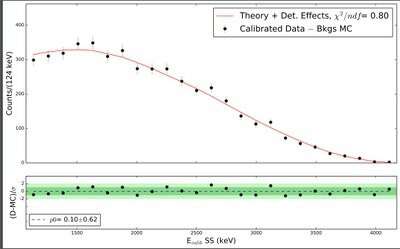#A step forward in solving the reactor-neutrino flux problem
“#A step forward in solving the reactor-neutrino flux problem”

Joint effort of the nuclear theory group at the University of Jyvaskyla and the international collaborative EXO-200 experiment paves the way for solving the reactor antineutrino flux problems. The EXO-200 collaboration consists of researchers from 26 laboratories and the experiment is designed to measure the mass of the neutrino. As a byproduct of the calibration efforts of the experiment the electron spectral shape of the beta decay of Xe-137 could be measured. This particular decay is optimally well suited for testing a theoretical hypothesis to solve the long-standing and persistent reactor antineutrino anomaly. The results of measurements of the spectral shape were published in Physical Review Letters in June 2020.
Nuclear reactors are driven by fissioning uranium and plutonium fuel. The neutron-rich fission products decay by beta decay towards the beta-stability line by emitting electrons and electron antineutrinos. Each beta decay produces a continuous energy spectrum for the emitted electrons and antineutrinos up to a maximum energy (beta end-point energy).
The number of emitted electrons for each electron energy constitutes the electron spectral shape and the complement of it describes the antineutrino spectral shape.
Nuclear reactors emit antineutrinos with an energy distribution that is sum of the antineutrino spectral shapes of all the beta decays in the reactor. This energy distribution has been measured by large neutrino-oscillation experiments. On the other hand, this energy distribution of antineutrinos has been built by using the available nuclear data on beta decays of the fission products.
The established reference for this construction is the Huber-Mueller (HM) model. Comparison of the HM-predicted antineutrino energy spectrum with that measured by the oscillation experiments revealed a deficit in the number of measured antineutrinos and an additional “bump”, an extra increase in the measured number of the antineutrinos between 4 and 7 MeV of antineutrino energy. The deficit was coined the reactor antineutrino anomaly or the flux anomaly and has been associated with the oscillation of the ordinary neutrinos to the so-called sterile neutrinos which do not interact with ordinary matter, and thus disappear from the antineutrino flux emitted by the reactors. Up to recently there has not been a convincing explanation for the appearance of the bump in the measured antineutrino flux.
Only recently a potential explanation for the flux anomaly and bump has been discussed quantitatively. The flux deficit and the bump could be associated to omission of accurate spectral shapes of the so-called first-fobidden non-unique beta decays taken into account for the first time in the so-called ‘HKSS’ flux model (from the first letters of the surnames of the authors, L. Hayen, J. Kostensalo, N. Severijns, J. Suhonen, of the related article).
How to verify that the HKSS flux and bump predictions are reliable?
“One way is to measure the spectral shapes of the key transitions and compare with the HKSS predictions. These measurements are extremely hard but recently a perfect test case could be measured by the renowned EXO-200 collaboration and comparison with our theory group’s predictions could be achieved in a joint publication [AlKharusi2020]. A perfect match of the measured and theory-predicted spectral shape was obtained, thus supporting the HKSS calculations and its conclusions. Further measurements of spectral shapes of other transitions could be anticipated in the (near) future”, says Professor Jouni Suhonen from the Department of Physics at the University of Jyvaskyla.
More information:
S. Al Kharusi et al, Measurement of the Spectral Shape of the β -Decay of Xe137 to the Ground State of Cs137 in EXO-200 and Comparison with Theory, Physical Review Letters (2020). DOI: 10.1103/PhysRevLett.124.232502
A step forward in solving the reactor-neutrino flux problem (2020, June 17)
retrieved 17 June 2020
from https://phys.org/news/2020-06-reactor-neutrino-flux-problem.html
This document is subject to copyright. Apart from any fair dealing for the purpose of private study or research, no
part may be reproduced without the written permission. The content is provided for information purposes only.
If you want to read more Like this articles, you can visit our Science category.
if you want to watch Movies or Tv Shows go to Dizi.BuradaBiliyorum.Com for forums sites go to Forum.BuradaBiliyorum.Com


